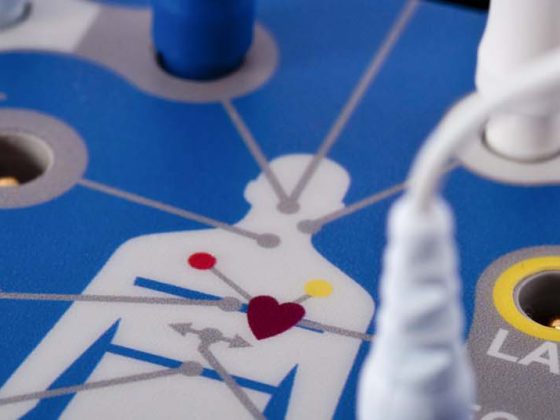The 24th German Skin Cancer Congress took place in Frankfurt am Main from September 11-13, 2014. In the following, some interesting casuistics, cohort, retro- and prospective studies from different German hospitals are presented. They illustrate the dynamics that currently prevail in this research field.
(ag) A multicenter, single-arm phase II study (DeCOG) reassessed the safety and efficacy of ipilimumab in patients with cutaneous melanoma as well as rarer forms. Although ipilimumab, an approved monoclonal antibody (anti-CTLA-4) for immunotherapy, has already shown a benefit in overall survival in two phase III trials in previously treated and untreated patients with metastatic melanoma, DeCOG was designed to reassess whether these results are reproducible in daily routine, or whether further questions arise in its application, especially in rare melanoma subgroups.
Methods: Pretreated patients with cutaneous, mucosal and ocular melanoma as well as MUP (“melanoma of unknown primary tumor”) in stages III or IV with unresectable tumor were included. In addition, untreated patients with metastatic ocular melanoma were included. Patients received four cycles of ipilimumab (3 mg/kgKG at 3-week intervals) and were assessed at baseline and weeks 12, 24, 36, and 48 (assessment using RECIST 1,1). The primary endpoint was overall survival at twelve months.
Results: In 25 German centers, they included 156 patients (83 with cutaneous, 7 with mucosal, 53 with ocular melanoma, and 13 with MUP). The 12-month survival rates were 37% in the cutaneous group, 14% in the mucosal group, 22% in the ocular group, and 27% in the MUP group. The median overall survival after the first dose was 6.9 months. The overall response rates in the 104 evaluable cases were 16% (cutaneous), 17% (mucosal), 9% (ocular), and 11% (MUP). There was one patient with complete response, 13 with partial response, and 23 with stable disease. 68% of patients showed treatment-associated adverse events (25% grade 3 or 4) and one drug-related death occurred (pancytopenia).
Conclusion: The study investigators see ipilimumab as a treatment option for patients with cutaneous melanoma as well as those with ocular and mucosal melanoma and MUP – with a toxicity that is controllable.
Second malignancies clustered in primary cutaneous lymphomas?
Although primary cutaneous T- and B-cell lymphomas constitute the second most common group of extranodal non-Hodgkin’s lymphomas, they tend to be among the rarer oncologic entities, with an incidence of approximately 1:100,000 population. For some time, they have been suspected of being associated with a higher rate of second malignancies. In particular, cutaneous T-cell lymphomas (CTCL) have been studied variously in the literature, whereas similar B-cell lymphomas (CBCL) have been studied less.
Methods: In a cohort study from Germany, 213 patients with a confirmed diagnosis of cutaneous lymphoma were now screened for secondary diseases (subdivided into solid tumors, skin tumors and lymphoid/hematologic neoplasms). In the time course to the initial diagnosis of cutaneous lymphoma, their occurrence was documented. Recurrences or second tumors of the same entity were counted only once.
Results: In 63 patients, a total of 92 malignancies developed as secondary or tertiary neoplasms, including nine melanomas, 28 invasive epithelial and 24 solid tumors, eight Bowen’s disease, and two carcinomas in situ of the cervix and breast. Lymphoid/hematologic neoplasms were found in 14 patients (6.6%).
Conclusion: There was indeed an increased incidence of second malignancies in this collective – especially hematologic neoplasms, but also malignant melanomas occurred with above-average frequency. Epithelial skin tumors, on the other hand, were found at a frequency consistent with age. Among solid tumors, carcinomas of the genitourinary tract were conspicuously present.
Short-term administration of vemurafenib for nine days
A casuistry of the BRAF serine-threonine kinase inhibitor vemurafenib illustrated the effects of short-term intermittent administration in a 79-year-old patient with stage IV malignant MUP. Vemurafenib is approved for the treatment of patients with nonresectable or metastatic melanoma with a BRAF V600 mutation. Compared with dacarbazine, the agent achieved significant improvements in overall and progression-free survival in studies. However, in most patients, resistance develops and progression occurs after six to eight months. Few reports of success with short-term intermittent administration exist, and the mechanism behind it is currently entirely unclear.
Case report: The patient under study was initially diagnosed with MUP in 2009. She developed inguinal and retroperitoneal lymph node metastases and an adrenal metastasis – each was surgically removed. Six cycles of dacarbazine were administered at the appearance of pulmonary, pleural, and paraaortic metastases, and treatment with vemurafenib was started after progression and if the BRAF V600 mutation was positive (960 mg 2×/d). Soon after the start of therapy, after ten days, the patient developed a violently itchy, intolerable, maculo-papulopustular exanthema (according to CTC grade 2), which resulted in the discontinuation of vemurafenib and a longer pause in therapy (due to the low tumor burden, the physicians considered this to be justifiable). Just over three months later, CT thorax/abdomen showed regression of pulmonary filiae and lymph node metastases. Even as late as 25 months after discontinuation of vemurafenib therapy, staging studies showed no evidence of new metastasis, so the agent was not restarted.
Consequently, in this patient with low tumor burden, a single administration of vemurafenib over nine days resulted in a complete remission of the tumor, which had already lasted 25 months by the time of the presentation at the congress. The authors therefore advocate clinical trials of intermittent short-term administration of the drug. Only in this way could the underlying mechanism possibly be better understood.
Combination therapy vemurafenib and ipilimumab
Shortly after the impressive results of vemurafenib and ipilimumab, a combination of the two agents was considered – mainly because of the expected development of resistance under BRAF inhibition. Following the occurrence of increased hepatotoxicity, a phase I trial in ten patients had to be discontinued. The only positive news: the observed side effects were all reversible.
Method: In a new study at Heidelberg University Hospital, the combination therapy was now tested again in eleven patients. They received full-dose vemurafenib therapy for symptomatic disease with a high tumor burden, and in two patients the dose later had to be reduced due to cutaneous side effects. After at least four weeks of vemurafenib alone (median 12 weeks), additional ipilimumab therapy (4 cycles 3 mg/kg bw) was started.
Results: Overall, the combination therapy showed good tolerability. Six of eleven patients showed elevated transaminase levels, three showed exanthema, and three showed diarrhea. Thus, although hepatotoxicity was the most relevant side effect, it was never associated with worsening of general condition. It was always reversible after pausing vemurafenib. Partial remission or stable disease was achieved by the combination therapy in seven of eleven patients. The median progression-free survival was six months, and the median overall survival was eleven months.
CONCLUSION: Although the study investigators referred to the increased hepatotoxicity that occurred analogous to the aforementioned study, they considered it to be clinically well-controllable. However, the differential diagnosis to ipilimumab-induced autoimmune hepatitis was complicated. Overall, the present results speak in favor of the combination, according to the authors: It is certainly a therapeutic option, especially in patients who cannot take ipilimumab as first-line therapy due to a strongly progressive disease.
Complete remission under BRAF inhibition – what comes after?
It was agreed that BRAF inhibition showed high response rates in patients with unresectable metastatic melanoma with BRAF mutation (50% of cases partial remission, 3-6% complete remission). However, how long should the drug be continued after complete remission or what is the course after discontinuation of inhibition? This question is still unresolved and was the subject of discussion at the congress.
Methods: Ten patients with unresectable metastatic malignant melanoma with complete remission were retrospectively studied. Nine had received vemurafenib, and one had received dabrafenib. The subjects had all stopped BRAF inhibition at some point – six because of side effects, four at their own request.
Results: On average, complete remission occurred after 8.75 months. Five patients continued BRAF inhibition beyond the time of complete remission (mean 13 months). Six of the ten patients experienced a recurrence of malignant melanoma an average of 7.2 months after discontinuation of therapy, and five were treated with a new dose of BRAF inhibitor. These five patients were followed in the further course, three of them achieved a new complete remission, one showed an unchanged finding in the staging.
Conclusion: So, according to the researchers, at least half of remission patients may experience a relapse after discontinuation, but seem to respond well to restart.
Long-term response rates are possible
Both ipilimumab and vemurafenib show longer-term response rates in smaller patient populations. The Skin Cancer Center in Mainz wanted to evaluate this circumstance again.
Methods: In a retrospective survey, we reviewed data from all patients (n=83) with non-resectable metastatic cutaneous melanoma treated with ipilimumab (n=41) or vemurafenib (n=42) at the Mainz Clinic between May 2010 and February 2014. Patients who had received both agents during the course of their disease were excluded. For the evaluation, overall survival, duration of therapy, and final response were considered. Long-term survival was defined as at least 18-month survival after treatment initiation.
Results: On average, overall survival was 11.5 months (0-42 months) in the ipilimumab group and 9.8 months (1-43 months) in the vemurafenib group. Nine patients in the ipilimumab group (22%) and six patients in the vemurafenib group (14.3%) were considered long-term survivors. 33.3% of ipilimumab long-term responders were receiving re-induction therapy; for vermurafenib, 66.6% of long-term responders were still on medication at the time of presentation. Complete remission was achieved by four patients on ipilimumab and five on vemurafenib.
Conclusion: Thus, according to the study investigators, everyday practice also shows that long-term response rates are possible in advanced melanoma. 22 or 14.3% of treated patients achieved survival of at least 18 months. The goal must be to determine which patients are potential long-term responders by means of subgroup analyses in larger collectives before therapy and then to assign them to the best possible respective therapy.
Source: 24th German Skin Cancer Congress, September 11-13, 2014, Frankfurt am Main, Germany.
InFo ONCOLOGY & HEMATOLOGY 2014; 2(8): 28-30.











